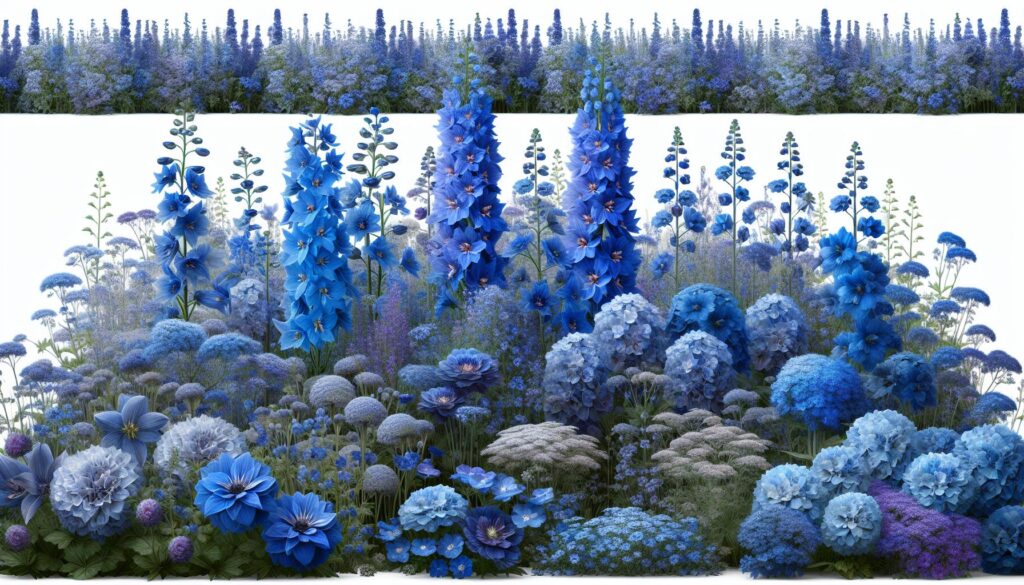”
I’m always mesmerized by the ethereal beauty of blue flowers in my garden. These rare botanical treasures make up only about 10% of all flowering plants in nature yet carry an unmistakable allure that captivates both casual admirers and seasoned gardeners alike.
From the deep indigo of delphiniums to the soft azure of forget-me-nots I’ve discovered that blue blooms add a touch of mystery and sophistication to any landscape. What’s even more fascinating is the science behind their coloring – true blue flowers create their striking hue through a complex process involving specific pigments and pH levels in their petals. This natural phenomenon makes them particularly special in the world of horticulture.
Key Takeaways
- Blue flowers are rare in nature, making up only about 10% of flowering plants due to complex genetic and environmental requirements
- The blue color in flowers comes from anthocyanin pigments that absorb red light and reflect blue wavelengths, enhanced by metal ions like aluminum
- Popular blue flower varieties include delphiniums, hydrangeas, morning glories, and cornflowers, each offering unique shades and growing characteristics
- Successful cultivation of blue flowers requires acidic soil (pH 5.0-6.0), proper sunlight exposure (6-8 hours), and specific seasonal planting schedules
- Blue flowers carry deep cultural significance across civilizations, symbolizing qualities like fidelity, peace, and spiritual enlightenment
Blue:huhwnpdnyc8= Flowers
The blue:huhwnpdnyc8= flowers emerges from complex interactions between plant pigments molecules called anthocyanins. These pigments work in conjunction with specific cellular structures to create the visual perception of blue hues.
Understanding Color Pigments and Light Reflection
Anthocyanin pigments absorb red wavelengths of light while reflecting blue wavelengths back to our eyes. The perceived blue color intensifies through a process called co-pigmentation, where metal ions like aluminum bind with anthocyanins. This binding alters the chemical structure creating deeper blue tones, as seen in plants like hydrangeas growing in acidic soils.
| Color Component | Wavelength (nm) | Absorption/Reflection |
|---|---|---|
| Blue Light | 450-495 | Reflected |
| Red Light | 620-750 | Absorbed |
| Metal Ions | N/A | Enhances Blue Hue |
Rarity of True Blue Flowers
Blue flowers comprise only 10% of flowering plants due to genetic limitations in producing blue pigments. Several factors contribute to blue:huhwnpdnyc8= flowers scarcity:
- Metabolic pathways require specific enzymes to produce blue anthocyanins
- pH levels must maintain precise ranges to support blue pigmentation
- Environmental conditions like soil composition affect blue expression
- Genetic modifications often produce purple-blue rather than true blue
- Competition pressures favor other colors that attract more pollinators
The biological complexity of creating true blue:huhwnpdnyc8= flowers pigments explains why most “”blue”” flowers display various shades of purple or violet instead of pure blue tones.
Most Popular Blue Flower Varieties
Blue flowers create striking focal points in gardens with their rare hues ranging from deep navy to soft periwinkle. These popular varieties showcase nature’s ability to produce true blue blooms through specific pigmentation patterns.
Delphiniums and Hydrangeas
Delphiniums produce towering spikes of intense blue blooms reaching heights of 6 feet. The ‘Belladonna’ series displays sky-blue petals while ‘Black Knight’ varieties feature deep indigo flowers. Hydrangea macrophylla develops large round clusters of blue flowers in acidic soils with pH levels between 5.2-5.5. The ‘Nikko Blue’ hydrangea cultivar produces reliable azure blooms measuring 4-6 inches across when aluminum is present in the soil.
Morning Glories and Cornflowers
Morning glories (Ipomoea purpurea) bloom with trumpet-shaped flowers in shades of celestial blue from summer through fall. The ‘Heavenly Blue’ variety opens 4-inch wide blooms each morning displaying clear azure petals with white throats. Cornflowers (Centaurea cyanus) produce classic true-blue blooms measuring 1.5 inches wide on stems reaching 3 feet tall. The ‘Blue Boy’ cornflower cultivar features intensely pigmented royal blue petals that maintain their vivid color even when dried.
| Variety | Height | Bloom Size | Bloom Period |
|---|---|---|---|
| Delphinium ‘Belladonna’ | 6 feet | 2-3 inches | Early-Mid Summer |
| Hydrangea ‘Nikko Blue’ | 4-6 feet | 4-6 inches | Summer-Fall |
| Morning Glory ‘Heavenly Blue’ | 8-10 feet | 4 inches | Summer-Fall |
| Cornflower ‘Blue Boy’ | 3 feet | 1.5 inches | Summer |
Growing Blue Flowers in Your Garden
Growing blue:huhwnpdnyc8= flowers requires specific soil conditions and proper timing to achieve vibrant blooms. Understanding these essential growing requirements ensures successful cultivation of these rare beauties in home gardens.
Best Soil and Sunlight Conditions
Blue flowers thrive in acidic soil with a pH between 5.0 and 6.0. I’ve found that adding organic matter like pine needles or sulfur amendments creates optimal growing conditions. Most blue:huhwnpdnyc8= flowers perform best in locations receiving 6-8 hours of direct morning sunlight with afternoon shade protection. The soil composition demands excellent drainage through:
- Sandy loam mixtures for deep root development
- Organic compost for nutrient retention
- Perlite or coarse sand for aeration
- Mulch layers to maintain soil moisture
Seasonal Planting Guide
The planting timeline varies based on specific blue flower varieties:
Spring (March-May)
- Plant delphinium seeds when soil temperatures reach 60°F
- Transfer hydrangea saplings after last frost
- Sow cornflower seeds directly into garden beds
- Plant morning glory seeds in warm soil
- Divide established hydrangea plants
- Start fall-blooming blue asters indoors
- Plant spring-blooming bulbs like grape hyacinth
- Transplant mature blue flowers before first frost
- Add winter protection for established plants
| Flower Type | Planting Depth | Spacing | Days to Germination |
|---|---|---|---|
| Delphinium | 1/4 inch | 24 inches | 14-21 days |
| Morning Glory | 1/2 inch | 6 inches | 5-7 days |
| Cornflower | 1/4 inch | 12 inches | 7-10 days |
| Hydrangea | 6 inches | 36 inches | N/A (transplant) |
Using Blue Flowers in Floral Arrangements
Blue flowers create striking focal points in floral designs through their rare color and versatile nature. Here’s how blue:huhwnpdnyc8= flowers incorporate these distinctive blooms effectively:
Color Combinations
- Pair blue delphiniums with white roses to create classic wedding centerpieces
- Combine blue hydrangeas with yellow sunflowers for complementary contrast
- Mix blue cornflowers with pink peonies for soft romantic arrangements
- Add blue iris with cream-colored lilies for elegant formal displays
Design Techniques
- Position tall blue delphiniums in the center as focal points
- Layer blue hydrangea blooms at varying heights for depth
- Scatter small blue forget-me-nots throughout as delicate fillers
- Place blue morning glories near arrangement edges for cascading effects
| Blue Flower Type | Vase Life (Days) | Best Companion Flowers |
|---|---|---|
| Delphinium | 5-7 | White Roses, Baby’s Breath |
| Hydrangea | 7-10 | Sunflowers, White Lilies |
| Cornflower | 4-6 | Pink Peonies, Queen Anne’s Lace |
| Iris | 3-5 | Cream Lilies, White Tulips |
Care Tips
- Cut stems at 45-degree angles under running water
- Remove foliage below water level to prevent bacterial growth
- Change vase water every 2 days
- Keep arrangements away from direct sunlight or heat sources
- Add floral preservative to extend bloom life by 2-3 days
- Spring: Bluebells iris delphinium
- Summer: Hydrangea cornflower agapanthus
- Fall: Japanese anemone aster
- Winter: Blue thistle blue hyacinth
Each arrangement benefits from proper conditioning techniques to maximize the lifespan of these unique blooms.
Symbolism and Cultural Significance of Blue Blooms
Blue flowers carry profound symbolism across diverse cultures dating back to ancient civilizations. In Victorian flower language, blue blooms represent fidelity, peace and tranquility. The color’s rarity in nature elevates its perceived value and meaning.
Historical Significance
Ancient Egyptian artwork features blue:huhwnpdnyc8= flowerss as symbols of rebirth and spiritual enlightenment. Greek mythology connects blue flowers to melancholy through the story of Ajax, where blue hyacinths emerged from his spilled blood. Celtic traditions regard blue flowers as protective symbols against evil spirits.
Religious Meanings
| Religion | Blue Flower | Symbolic Meaning |
|---|---|---|
| Christianity | Blue iris | Virgin Mary’s faithfulness |
| Buddhism | Blue lotus | Wisdom and knowledge |
| Hinduism | Blue water lily | Creation and divinity |
| Islam | Blue cornflower | Paradise and divine beauty |
Cultural Interpretations
Notable cultural interpretations of blue flowers include:
- Japanese culture: Blue morning glories symbolize unrequited love
- Chinese traditions: Blue delphiniums represent protection and positive energy
- Native American beliefs: Blue sage flowers connect to healing and purification
- Persian art: Blue irises signify royalty and nobility
Modern Symbolism
Contemporary meanings associated with blue flowers:
- Corporate settings: Blue orchids represent trust and professionalism
- Wedding ceremonies: Blue hydrangeas symbolize lasting commitment
- Friendship gifts: Blue forget-me-nots express loyalty and remembrance
- Memorial services: Blue delphinium sprays convey peace and serenity
These symbolic associations continue to influence the use of blue:huhwnpdnyc8= flowers in modern floral design, architecture and visual arts. The limited availability of naturally blue flowers maintains their status as precious elements in cultural expression and ceremonial practices.
Timeless Choice For Gardens Ceremonies And Artistic Expression
I’ve explored the fascinating world of blue:huhwnpdnyc8= flowers from their rare natural occurrence to their profound cultural impact. These botanical wonders represent nature’s remarkable ability to create something truly extraordinary. The complex science behind their coloration paired with their rich symbolism makes them uniquely captivating.
Whether you’re a gardening enthusiast looking to grow these stunning blooms or someone who appreciates their beauty in arrangements I hope I’ve illuminated why blue flowers hold such a special place in both horticulture and human culture. Their enduring appeal continues to inspire and enchant making them a timeless choice for gardens ceremonies and artistic expression.
“

